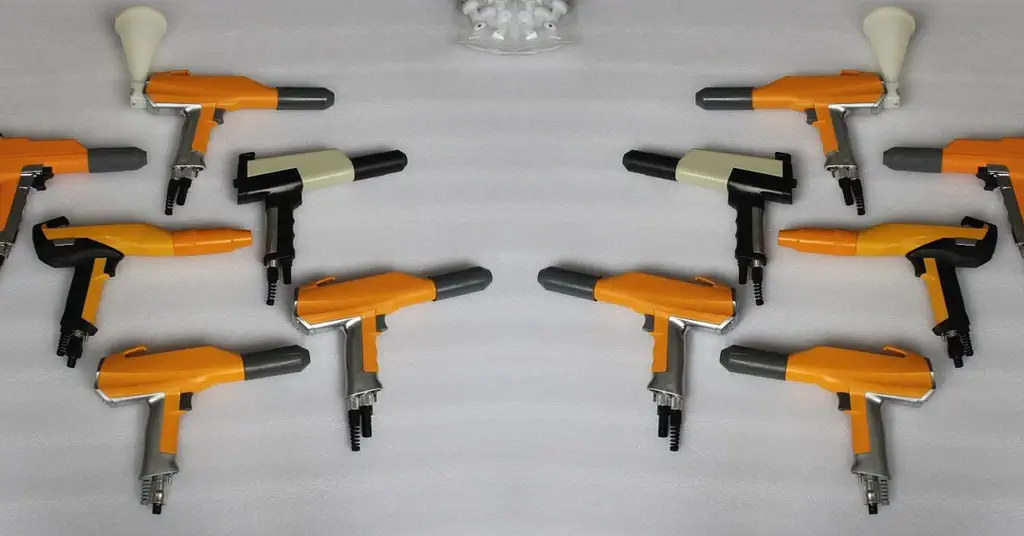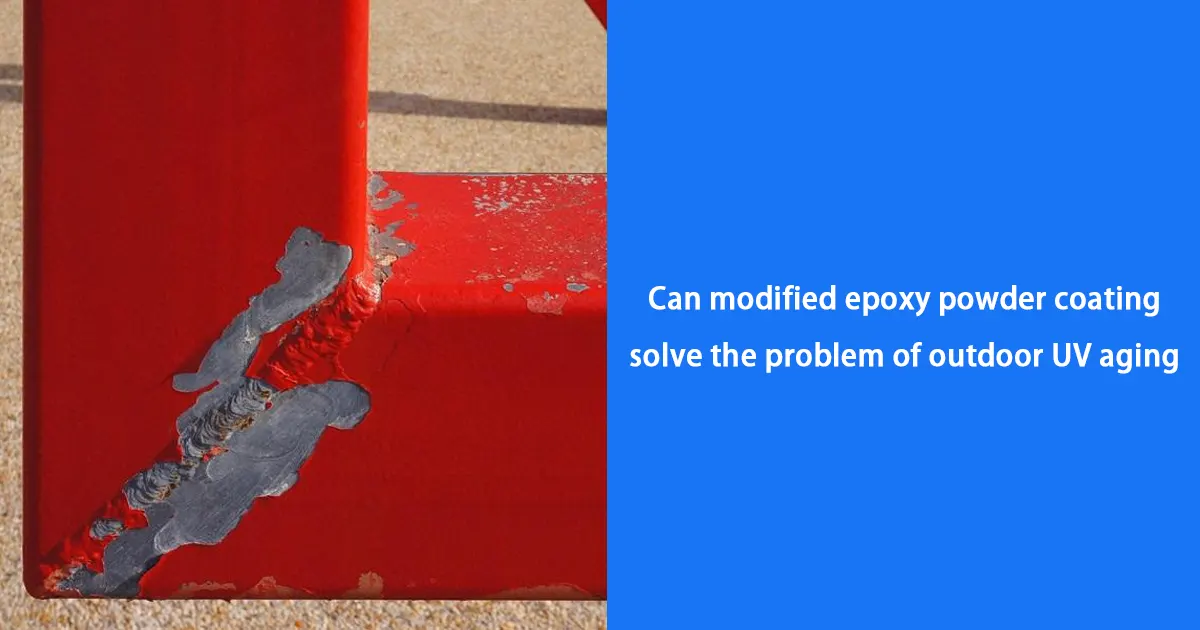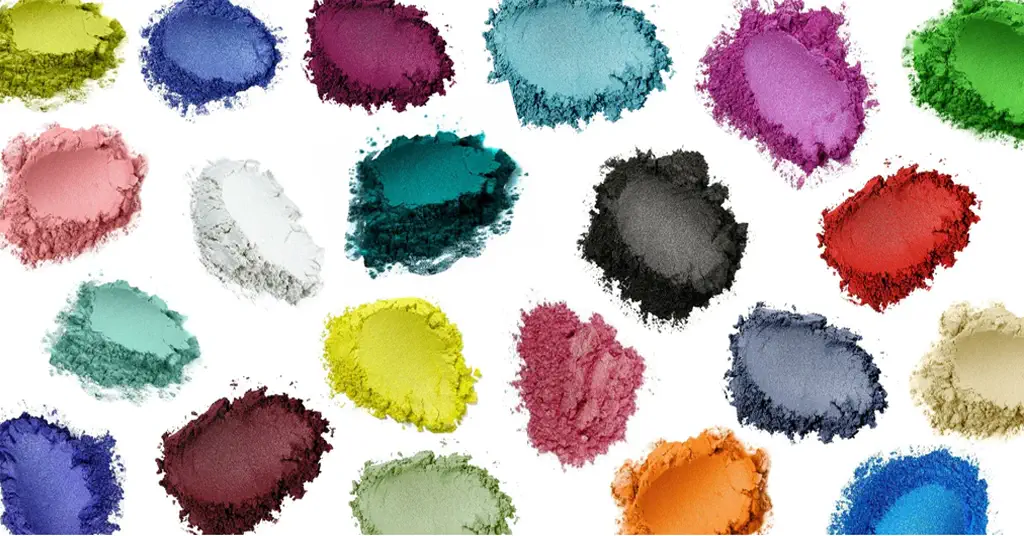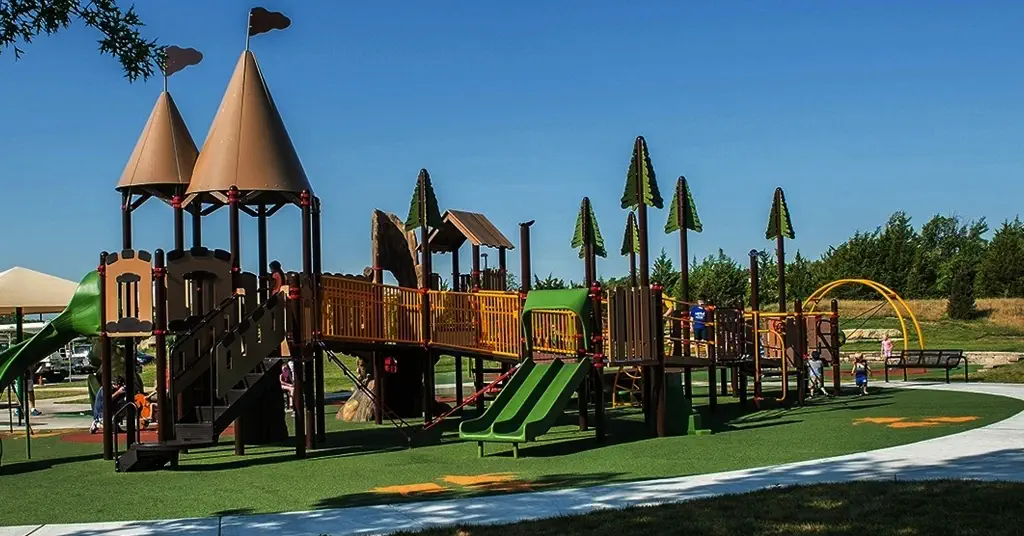Powder Coating Guns: Everything You Need to Know
In the field of powder coating, the powder coating gun is an indispensable key tool. This article will reveal it all, from operating tips to the best options, and pinpoint the benefits of a powder coating gun. Mastering this key information will bring about a qualitative leap in your powder coating work. Whether you’re a beginner or a seasoned pro, we’ll provide practical insights to help you navigate the world of powder coating. Let us delve deeper and bring you the best of this compelling field.
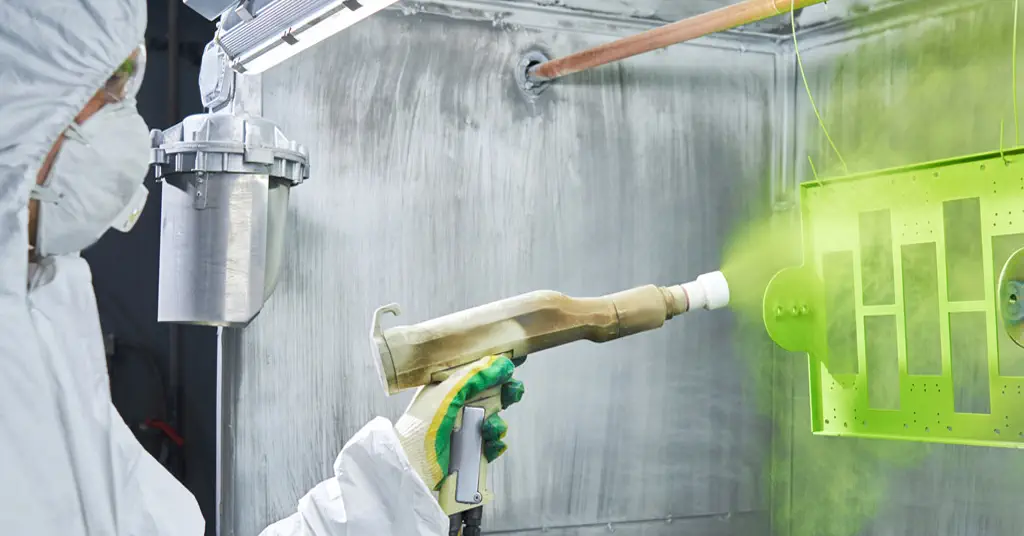
1. How Powder Coating Works
a. Analysis of powder coating process
Powder coating is an efficient and environmentally friendly surface coating method that is as precise as it is stunning. First, powder coating is sprayed evenly on the surface of the object to be coated in the form of powder. The key to this step is the charge effect. Through electrostatic adsorption, the powder particles adhere closely to the surface of the object. Next, we enter the baking stage. The coating is placed in a high-temperature oven where the powder particles quickly melt and fuse to form a strong coating. This unique coating process ensures excellent adhesion and consistent powder coating quality.
b. The role of powder coating gun in the process
The powder coating gun is one of the key elements of the entire process. Its working principle is based on electrostatic spraying technology, which charges the powder to deposit it accurately and evenly on the surface of the workpiece. The design and adjustment of the powder coating gun directly affects the thickness and uniformity of the coating, so selecting the appropriate spray gun is crucial to achieving ideal results.
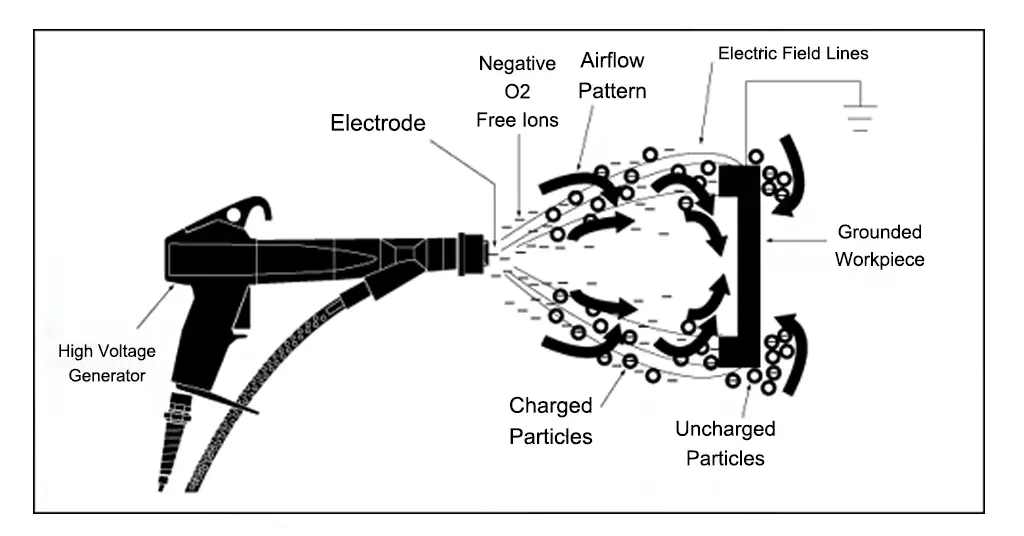
Powder coating technology brings many benefits. First of all, it is a solvent-free coating method that does not produce volatile organic compounds and complies with environmental standards. Secondly, due to the electrostatic adsorption effect, the powder coating is more uniform and less prone to problems such as dripping and falling. In addition, the high temperatures during the baking process ensure that the coating is strong and durable, with excellent corrosion resistance and durability.
2. Types of Powder Coating Guns
a. Traditional powder coating gun
The traditional powder coating gun is one of the cornerstones of the powder coating field. The working principle of this gun is based on air pressure, which sprays powder onto the surface of the workpiece through an air flow. Although the operation is simple and suitable for beginners, it is relatively low in terms of coating uniformity and utilization. It is typically used for small-scale painting projects that require lower production efficiency.
b. Electrostatic powder coating gun
The electrostatic powder coating gun uses electrostatic spraying technology to achieve more precise and uniform coating by charging the powder. This gun is widely used in demanding painting tasks such as automobiles, electronic products, etc. The benefit is improved coating adhesion and consistency while reducing scrap.
c. Electric powder coating gun
Electric powder coating guns use static electricity generated by triangular triboelectric charges to achieve precise spraying of extremely fine powder. This gun is characterized by its superior powder charging effect, which enables uniform coverage on the surface of complex-shaped workpieces. It is usually used in high-end applications where there are higher requirements for coating quality.
3. Components of a powder coating gun
a. Powder Coating Gun body
The gun body of the powder coating gun is its basic structure and bears the important tasks of bearing pressure and conveying powder. Usually made of high-strength materials to ensure stable work and durability for long-term use. Designed with a comfortable grip in mind, allowing the operator to maintain precise control during the painting process.
b. Powder Coating Control unit
The control unit is the brains of the powder coating process and is responsible for monitoring and adjusting various parameters of the gun. Through the control unit, the operator can adjust key parameters such as powder injection volume and charge intensity to adapt to the needs of different workpieces. Advanced control units often feature user-friendly interfaces that provide real-time monitoring and adjustment capabilities.
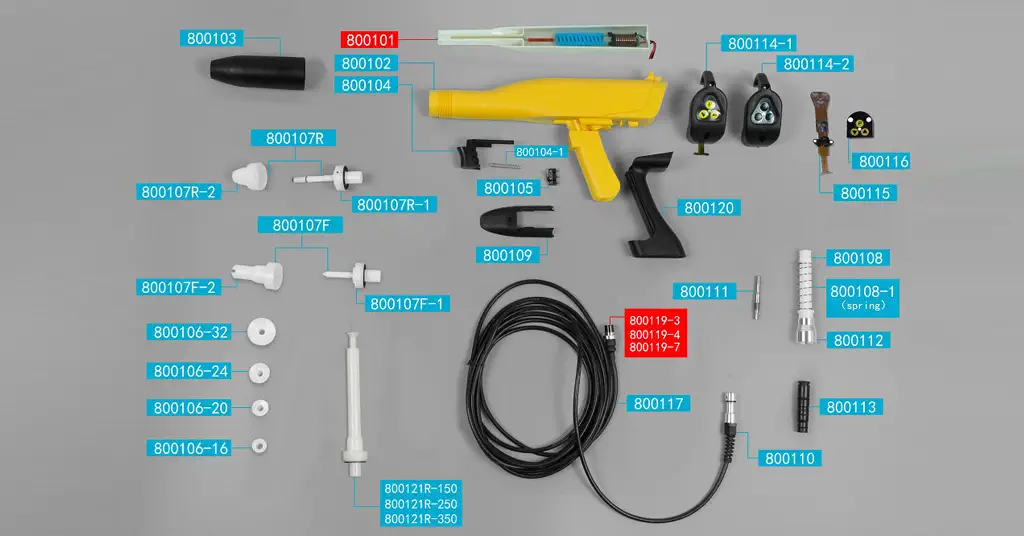
c. Powder hopper
The powder hopper is the powder storage part of the powder coating gun and is responsible for containing the powder coating. It is designed to ensure an even supply of powder, prevent clumping and keep the powder dry. Material and sealing properties are key features to prevent moisture and impurities from affecting the powder.
d. Electrostatic charging mechanism
The key to powder coating lies in the electrostatic charging mechanism, which charges the powder so that it can be accurately adsorbed on the surface of the workpiece. This mechanism usually includes a high-voltage generator and an electrode system to ensure that the powder has a certain charge to achieve precise electrostatic adsorption.
e. Nozzles and Applicators
The nozzle and applicator are the components in the powder coating process that most directly affect the quality of the coating. Its design includes nozzle shape, size and material selection to ensure uniform spraying and high-quality coatings. Applicator selection often depends on the requirements of the coating task, including coating thickness and surface coverage.
4. How To Operating a Powder Coating Gun
a. Setup and Preparation
Before operating a powder coating gun, proper setup and preparation are key to ensuring a smooth coating process. First, check to make sure the paint in the powder hopper is dry and free of clumps. Carefully inspect the gun body, nozzle, and applicator to ensure there are no impurities or damage. Before starting to paint, clean and prepare the workpiece surface to ensure coating adhesion and uniformity.
b. Adjust gun settings
Correctly adjusting the parameters of your powder coating gun is critical. Through the control unit, the powder injection volume, charge intensity and spray mode are adjusted to adapt to the needs of different workpieces. Precise adjustments ensure coating uniformity, increase production efficiency and reduce scrap. Regularly inspect and calibrate control units to maintain efficient operation.
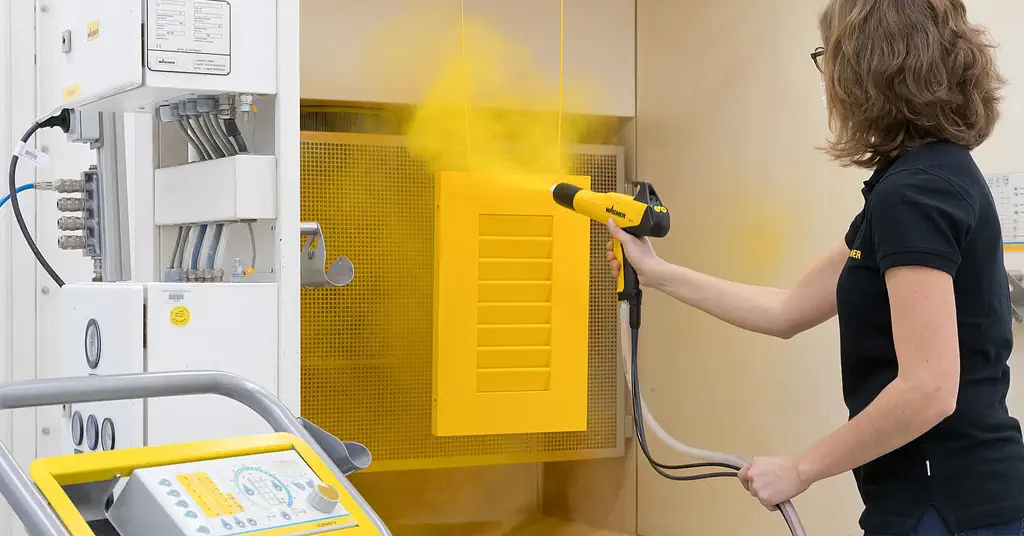
c. Application skills
Application techniques directly affect the quality and appearance of the coating. Maintain a certain spray distance and speed to ensure even coating distribution. Use an even back-and-forth motion to ensure the entire workpiece surface is covered. For complex-shaped workpieces, use appropriate nozzles and applicators, and adjust the nozzle angle for best results.
d. Security considerations
The powder coating process involves some safety issues that must be taken seriously. Operators should wear protective equipment, including respiratory protection and eye protection. Ensure the operating environment is well ventilated to prevent inhalation of dust and vapors. When cleaning and maintaining your powder coating gun, be sure to follow established safety procedures to guard against potential risks.
5. Advantages of Using Powder Coating Guns
a. Efficiency and material savings
Powder coating guns provide excellent efficiency and material utilization during the coating process. Compared with traditional coating methods, powder coating does not require solvents, avoids the emission of volatile organic compounds, and reduces paint waste. Due to the electrostatic adsorption effect, powder particles can adhere to the surface of the workpiece more accurately, improving the uniformity of the coating and reducing overspray.
b. High quality coating
Powder coating guns create impressive, high-quality coatings. Because the powder melts and fuses in a high-temperature environment to form a solid surface, the coating offers excellent corrosion resistance, abrasion resistance and durability. This robustness not only allows the coating to perform well in harsh environments, but also ensures long-term maintenance and service life.
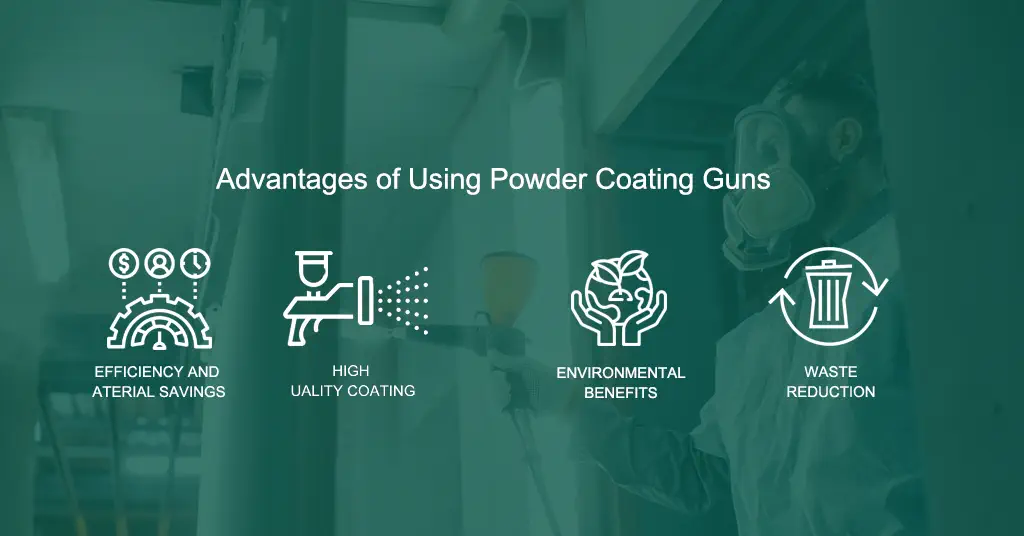
c. Environmental benefits
Powder coating technology is environmentally friendly and ideal for sustainable painting. Since no solvent is used, harmful gas emissions are reduced and pollution to the atmosphere and water sources is reduced. In addition, the powder coating process produces less waste and complies with modern environmental standards.
d. Waste reduction
Powder coating technology reduces waste generation compared to traditional painting. Due to the powder’s high degree of controllability and recyclability, unattached powder can be recycled and reused, minimizing waste. This not only helps with cost control but also with sustainable production and resource utilization.
6. Applications of Powder Coating Guns
Powder coating guns are widely used in industrial fields and have become the first choice for surface treatment. Industrial applications include metal products, mechanical parts, pipes and structural parts. Through powder coating technology, these industrial products can obtain high-quality, durable and anti-corrosion coatings, improving the overall quality and lifespan.
The automotive industry is one of the main beneficiaries of powder coating technology. From car exteriors to parts, powder coating provides excellent surface protection, not only against corrosion and scratches, but also provides a long-lasting appearance. Automakers choose powder coating both to improve appearance quality and to ensure long-term use of parts in harsh conditions.
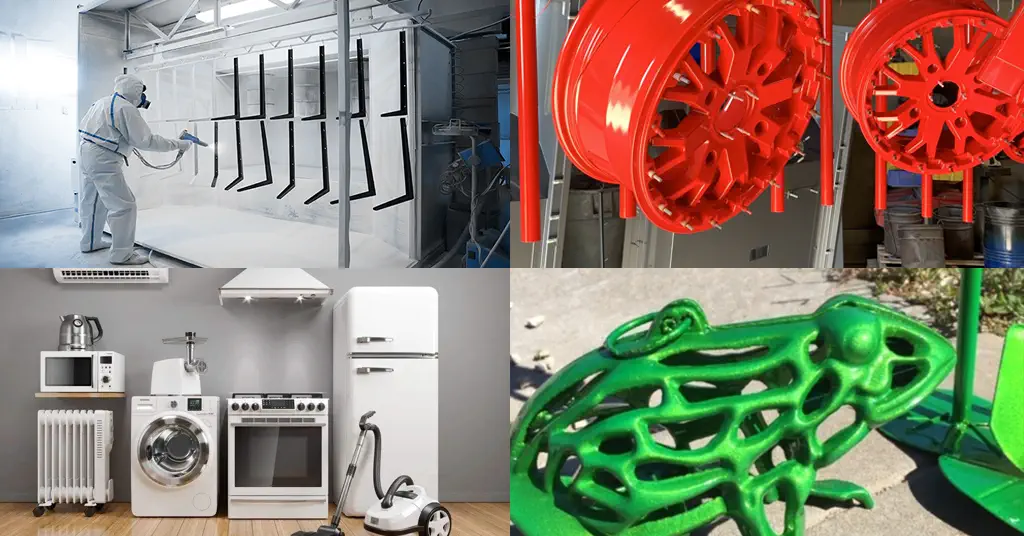
Powder coating technology is not limited to industry and large-scale manufacturing, it is also gradually penetrating into the home and DIY markets. For surface treatment of furniture, doors, windows, gardening tools, etc., high-quality and personalized coating effects can be achieved through powder coating. DIY enthusiasts can easily use powder coating guns for small-scale projects and enjoy a professional-grade painting experience.
d. Arts and Crafts Projects
Powder coating guns play a unique role in arts and crafts projects. Artists and craftspeople can use powder coating technology to give their creations long-lasting color and texture. From metal sculptures to home décor, powder coating offers a creative and highly effective surface treatment that makes artwork more eye-catching.
7. How To Selecting the Right Powder Coating Gun
a. Considerations
Choosing the right powder coating gun is an important step in ensuring a successful painting project. Consider the following factors to help you make an informed choice:
Painting project requirements: Different projects may have different requirements for the quality, durability and appearance of the coating. Make sure you choose a powder coating gun that meets the specific needs of your project.
Workpiece Type and Size: Different workpieces may require different types of powder coating guns. Large workpieces may require a gun with high spray efficiency, while complex shaped workpieces may require a gun with fine spray control.
Coating technology: Electrostatic spraying, traditional coating or electric spraying? Choose the appropriate coating technology based on your experience level and project requirements.
Budget: Powder coating guns range in price, make sure you choose one with good performance and durability within your budget.
b. Popular brands and models
In the market, there are some well-known brands and models of powder coating guns that receive great reviews. These include:
Wagner: Known for its high performance and reliability for a variety of painting applications.
Gema: Provides advanced electrostatic coating technology for demanding industrial projects.
Nordson: Its sophisticated control unit and innovative design make it the first choice for many professionals.
When choosing a powder coating gun, it is recommended to carefully research these brands and models based on your project needs, and consult user reviews and professional opinions to ensure your choice meets your actual needs.
Powder coating gun technology is an advanced tool in the field of surface coating. From powder coating gun types and components, to operating techniques and in-depth analysis of application areas, we provide a full range of information. Understanding how powder coating guns work, including traditional, electrostatic, and electric types, and the functions of each component can help you choose the equipment that best suits your project needs. Operating a powder coating gun requires delicate setup, adjustment and safety precautions, and different types of guns are used in a wide range of applications including industrial, automotive, home and art. Ultimately, by delving into the advantages of powder coating technology, we highlight its key benefits of high efficiency, high-quality coatings, environmentally friendly properties and reduced waste. When choosing the right powder coating gun, we recommend considering project needs, workpiece type, and budget, as well as looking at popular brands and models.

Erik
Doctor of Chemical Engineering, expert in the field of powder coatings, with over 20 years of professional experience in the research and application of powder coatings
Have Anything To Ask Us?
